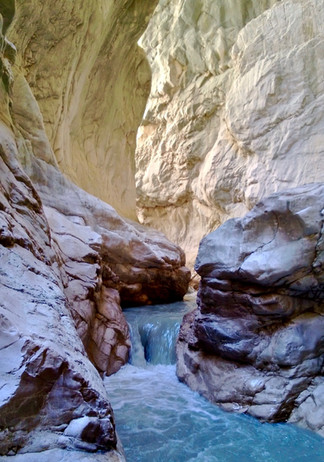Saklıkent - hidden city of ancient Lycia
- Frank Klaus Jordan

- Aug 19, 2018
- 2 min read
Updated: Aug 23, 2019

the 80 families of Xanthos
Right before dawn, the long train of refugees arrives at the foot of the mountain. For one long night they have walked up the Sirbe river leaving their homes and hopes behind. They are eighty families from Arinna, capital of Lukka, laden with the wealth and wisdom of their city. Groups of bloodstained warriors escorting the caravan of ox carts, protecting tired people and their crying children. They stop at a small opening between the 300m high sheer rock walls, where the mountain releases the roaring river into the plain. Through this secret crevice in the rocks, they enter the massive gorge behind. Protected by the vast sculptured walls towering high above, they reach the safety of the 'Hidden City'.
Legend has it that only 80 families of Xanthos 'Arinna', capital of Lycia 'Lukka', have survived the Persian invasion of 545 BC. There is a high probability that the city's survivors were hiding from the Persians in Saklıkent 'Hidden City', and that the canyon got its name from these people. About fifteen ancient caves have been found in the walls of the canyon. The Lycians were an ancient people who inhabited the area of present-day Turkey between the bays of Antalya and Fethiye. They were known in antiquity as a hard-working and wealthy people, neutral in world affairs but fierce in defending their freedom and ancestral traditions. Ancient Lycia is famous for its independent city-states, joined in a federation called the "Lycian League", a unique government. We will come back to these interesting people in some other blog posts.

Saklıkent
High above the fertile plains, the rushing torrents of meltwater have cut a narrow canyon through the Taurus mountains, creating Saklıkent National Park. There is a 720 meter altitude difference between entrance and exit of Saklıkent, which is Europe's 2nd-largest canyon. From April onwards, when most of the snowmelt from Taurus mountains have passed through the gorge, the canyon is walkable.
We enter this magnificent place by walking a suspended passageway, mounted to the wall of a ten meter crevice in the rock. Tall canyon walls, a staggering 300 m high, flank the river bed and the sound of water rushing through the ravine gives it a touch of adventure. In order to get into the canyon, we have to cross the river. Up to waist height in fresh mountain water, we cross through a ten meter stretch of the river, holding a safety cable to stand against the current. Now we walk up the river bed where the unusual beauty of the canyon walls create all sorts of marvellous shapes. The deeper we go into the canyon, the more obstructions we have to climb up. After about four km it is impossible to go further without mountaineering equipment. After a short rest, we turn and wade back through the ankle-high waters of the gorge.
After having spent a good part of the hot day in the canyon we don't leave the place before enjoying delectable fresh trout in one of the rustic restaurants at the river. Swinging in our hammocks, surrounded by the sounds and gentle cooling steam of fresh water from the canyon, we agree that nothing contributes more to serenity than a simple lifestyle.

























Comments